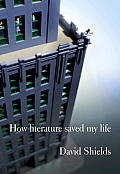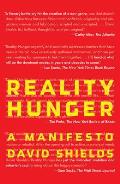
Heavily under the influence of self-reflexive documentary film (esp.
Ross McElwee) and anthropological autobiography (esp.
Renata Adler and
George W. S. Trow) and monologuists (
Eric Bogosian,
Spalding Gray,
Sandra Bernhard,
Chris Rock, Rick Reynolds,
Denis Leary,
Jonathan Goldstein,
Sarah Silverman, Joe Frank), I found my work gravitating away from fiction toward nonfiction, then away from narrative toward literary collage. Every year I was teaching a graduate seminar at the University of Washington in which the main course packet was a big blue binder of my favorite quotations — by everyone from
Heraclitus to
Sophie Calle — about the excitement of a certain kind of essayistic gesture. It wasn't memoir; it wasn't journalistic; it wasn't scholarship. It was something else. It was the idea that if you want to write seriously, you might be willing to break the forms (
Naipaul), that all great works of literature either dissolve a genre or invent one (
Walter Benjamin), that if all you do is worship masterpieces you remain a pupil and have no chance of becoming a master (
Prokofiev). I found all around me that the discussion of "nonfiction" defined the form downward — as some sort of literal transcription service — and I knew that wasn't what it felt like to write a book of "nonfiction" that strived to reach literary art.
Every year, this course packet became less repetitious, less full of typos, and I found myself pushing the passages — sometimes written by me, sometimes written by others, sometimes originally written by others and remixed by me — into rubrics, otherwise known as chapters. Stuff about memory clung to the chapter on memory; stuff about hip-hop clung to the hip-hop chapter. This course packet became my book Reality Hunger: A Manifesto, published a few years ago. The book was an attempt to evacuate the distinction between fiction and nonfiction, overturn the laws regarding appropriation, and encourage writers and other artists to create new forms for the 21st century.
The book generated a lot of discussion — much of it, to my ear, pretty beside the point. The talking points for the book became "the novel is dead" and "it's okay to steal stuff," neither of which I say. Here, too, there was method to my madness — the whole point of my remixing other people's words was that I wanted to embody on the page the idea I was arguing for: namely, when you are not sure, you are alive. Just as I was arguing for instability of genre, I wanted the reader to experience instability of provenance.
In some ways, Reality Hunger burned literature down to the ground. I wanted to write a book that built literature back up for myself. I wasn't trying to kill the patient; I was trying to save the patient. But the patient was terminal — that much I was sure of. So I wound up writing How Literature Saved My Life, which Knopf published last month. I think of it as practice to Reality Hunger's theory — or as one reviewer called it, "the heart to the manifesto's mind" (Minna Proctor, Bookforum). I like that phrase — how could I not? — and I see How Literature Saved My Life as a fairly explicit attempt to apply the collage techniques that I championed and theorized about in Reality Hunger (and, to a lesser extent, in Enough about You: Notes toward the New Autobiography in 2002). HLSML is more visceral than Reality Hunger, more vulnerable. I begin HLSML with an ode to Ben Lerner's great Leaving the Atocha Station. I teach Lerner's question as my own: How to feel now? How to create art now? HLSML is divided into eight chapters and it takes the reader on what I hope is a serious emotional journey, an intellectual detective story.
 I talk about my own ambivalence toward everything, including my own feelings; how difficult it is to get past yourself — to leave the Atocha Station — and fully love someone else; how difficult it is to get past the melancholy structure of the human (or only my?) mind; the unsolvable problem of death — how difficult I find it is to live a meaningful life in the shadow of mortality and without any religious consolation; I flirt, none too seriously, with suicide; I find affirmation and refuge in literature; but that quickly curdles and I crave a more naked art (see monologuists above) in which there is as little membrane as possible between life and art; I wonder if I even love art anymore or only artfully arranged life; and in the final chapter — which is meant to be genuinely suspenseful — I attempt to find a life and art that I can live with. Ironically, paradoxically, such art pivots on the very self-consciousness that has haunted me throughout the book (throughout my life).
I talk about my own ambivalence toward everything, including my own feelings; how difficult it is to get past yourself — to leave the Atocha Station — and fully love someone else; how difficult it is to get past the melancholy structure of the human (or only my?) mind; the unsolvable problem of death — how difficult I find it is to live a meaningful life in the shadow of mortality and without any religious consolation; I flirt, none too seriously, with suicide; I find affirmation and refuge in literature; but that quickly curdles and I crave a more naked art (see monologuists above) in which there is as little membrane as possible between life and art; I wonder if I even love art anymore or only artfully arranged life; and in the final chapter — which is meant to be genuinely suspenseful — I attempt to find a life and art that I can live with. Ironically, paradoxically, such art pivots on the very self-consciousness that has haunted me throughout the book (throughout my life).
I hugely love DFW's statement that we're existentially alone on the planet — you can't know what I'm thinking and feeling, and I can't know what you're thinking and feeling, but that literature at its best is a bridge constructed across the abyss of human loneliness. Wallace then went on to say that in fiction there is a huge amount of contrivance, but don't worry; we can get past this contrivance. That part of his statement I'm not in sympathy with. I want as thin a membrane, etc. I want a literature in which the writer foregrounds as fully as possible how he/she solves/solved/didn't solve the problem of being alive. I want a literature that doesn't allow us to escape existence but teaches us how to endure it (see Samuel Johnson). Such a literature I find truly loneliness-assuaging and life-saving.
More from David Shields on PowellsBooks.Blog: